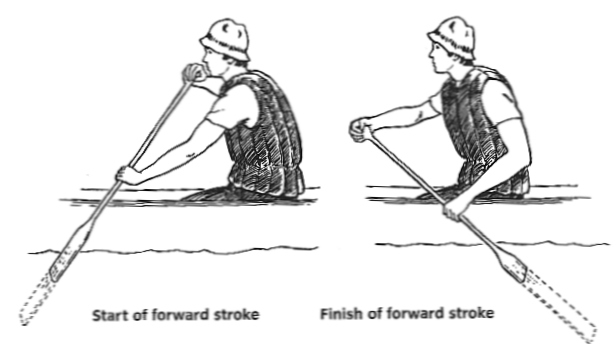
image from http://www.kayaktrainingaustralia.com.au/canoeng-skills/
A basic forward stroke is the first to learn, but possibly the most difficult to master. This stroke is used repeatedly over-and-over for a whole day, month, year - tens of thousands of times. Having an efficient and effective stroke will mean less fatigue and reduce the chance of repetitive stress injuries. The stroke should involve the whole body, not just the arms. There are lots of variations published on how to complete a forward stroke - some from the sprint/racing groups, others from more relaxed recreational paddlers. Two techniques have been provided below.
Although there is variance in techniques there are a few things that remain consistent: When paddling, the blade should be fully submerged in the water before applying force. The blade should be perpendicular to the direction of travel (vertical & horizontal). Enough force should be applied to pull the canoe forward without drawing air down behind the paddle (minimize whirlpools and aeration). Overall, the actual movement of the paddle blade in the water should be minimized during the power phase - think of the blade being static and pulling the canoe past the paddle.
How to execute an efficient forward stroke.
If you are paddling in a low seated 'marathon' canoe, try using a bucket seat and foot braces for support. Paddling with higher seats (or no seats) drop your knees either to the floor of the canoe or brace them against the sides or gunwales. In either case having a positive connection to the canoe through your lower body is critically important to an efficient forward stroke - this is where the paddling force is transferred to the canoe.
Because it is difficult to maintain a vertical paddle as you pull the canoe forward, using a bent shaft paddle may provide a significant increase in efficiency by keeping the blade vertical in the water for a longer period during the power phase.
The following two clips provide different examples of paddling styles used with a forward stroke depending on the power, control, and paddling personality. In each case submerging the blade in the water, stacked hands during the power phase, and vertical paddle are consistent. The length of the stroke and bend of the grip arm are the primary difference.
The standard forward stroke is relatively long, starting reasonably far forward, and continuing to pull until the hip. The forward catch is accomplished with modest body rotation, and slight forward lean.
A 'traditional' stroke has been advocated for long paddling days and as a more relaxed alternative. This stroke starts with the grip hand close to the cheek then punching out. The shaft hand may act as the fulcrum point. This stroke is very short (when compared to the above forward stroke) and a higher cadence is used. This stroke is often associated with the Canadian correction stroke. It has been described by many authors over time.
While making this page I was brought back to a discussion about what kind of class lever is a canoe paddle. In most of my reading a paddle is identified as a 3rd class lever with the fulcrum at the grip, effort applied by the shaft hand, and the resistance (or load) at the blade. When looking at the 'traditional' (Punch) or north-woods stroke the shaft hand is held relatively still and the grip is punched out - this kind of stroke would be considered a class 1 lever. Yes, this is a simplification. Both strokes use body rotation to facilitate the paddling motion and power. The fact that both the grip/shaft hand may actually be the fulcrum at different points in the stroke is also ignored.
The 3rd class lever (Standard Forward Above) has the advantage of contact time in the water to pull the boat forward. There is no mechanical advantage but if the paddler is strong enough there will be much more time to apply force over distance, and the blade remains perpendicular for a longer period. The distance between the grip hand and shaft hand should be maximized within the paddlers box (just my opinion).

The 1st class lever, assuming the shaft is longer than the blade, will have a mechanical advantage. Unfortunately there is a limitation on the length of the stroke, in particular the portion that is actually moving the canoe forward. The length of the 'punch' from the grip hand is also limited to the arm length of the paddler, which must be longer than the arc of the blade. To gain the greatest mechanical advantage the distance between the grip hand and fulcrum point should be maximized, the problem here is the stroke length becomes shorter (and shorter) until the stroke is so short any advantage is lost. If the length between the grip and fulcrum is shorter, the stroke is longer, but the mechanical advantage is lost, and the arc or swing of the blade still limits the maximum forward force. Slow Motion of Traditional Forward noting Fulcrum Point.

Back to Home Page
Back to my Canoe Instruction WWW page
Paddle Manitoba Home Page
If you have any questions or comments please send me Email: burc...@cc.umanitoba.ca